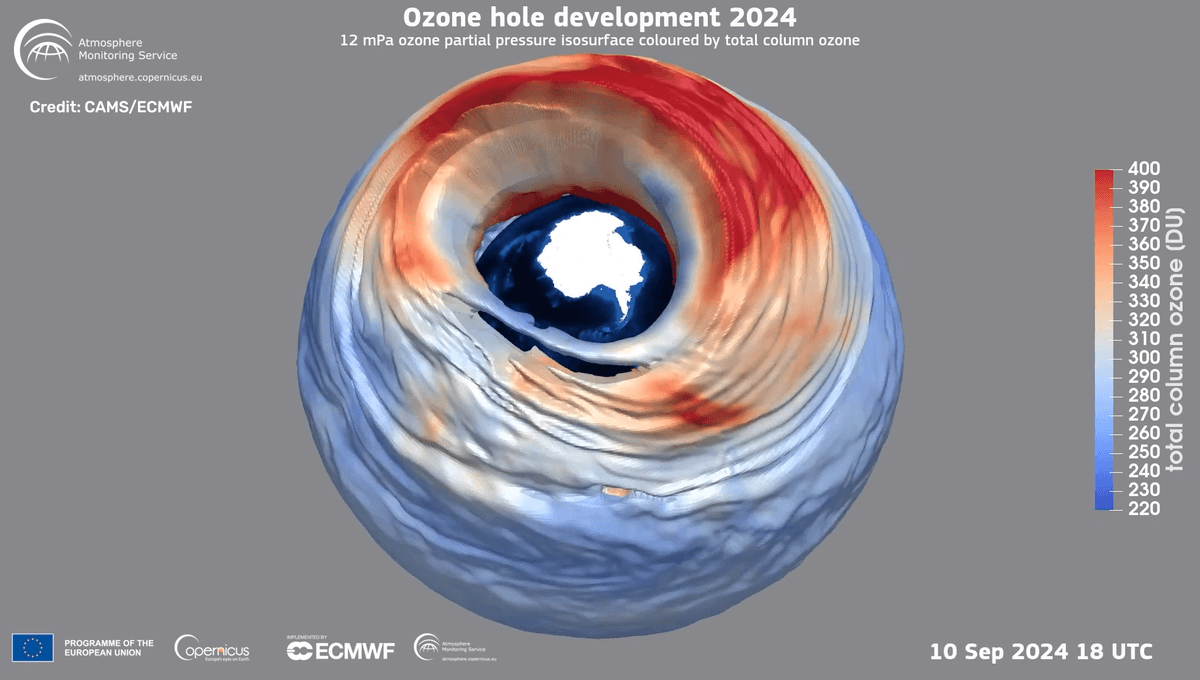
The ozone hole over Antarctica is relatively small and healthy at the moment, providing further proof that the ozone layer is on the path toward a full recovery.
That’s the good news. The bad news is that the current size of the ozone hole is linked to sudden stratospheric warming over Antarctica in July that resulted in freakishly hot temperatures across large parts of the continent.
Aside from worryingly warm temperatures around the South Pole, the latest data on the ozone layer is positive. The current trend suggests the ozone could fully recover to 1980 levels (before any hole in the ozone layer appeared) by around 2066 over the Antarctic, over the Arctic by 2045, and by 2040 for the rest of the world.
“The ozone layer, once an ailing patient, is on the road to recovery,” UN Secretary-General António Guterres said in a statement.
The ozone layer is a region of the stratosphere between 15 and 30 kilometers (9.3 to 18.6 miles) above Earth’s surface that has a high concentration of the gas ozone compared to other parts of the atmosphere.
By absorbing some of the Sun’s harmful ultraviolet rays, it acts as a shield for life on our planet. In the 1970s and ’80s, it became apparent that a gaping hole in the ozone sheet was being formed by chlorofluorocarbons (CFCs) – human-made chemicals once widely used in aerosol sprays, solvents, and refrigerants – that degrade the layer after becoming wafted up into the stratosphere.
The World Meteorological Organization released the latest update on World Ozone Day, September 16, which marks the anniversary of the Montreal Protocol in 1987, an international agreement that effectively outlawed CFCs around the world.
It was arguably one of the most successful international agreements ever reached. To date, it remains the only UN treaty that has been ratified by all 197 parties.
“At a time when multilateralism is under severe strain, the Montreal Protocol stands out as a symbol of hope,” added Guterres in the recent comments. “When countries show political resolve for the common good, change is possible.”
The ozone layer is complex, however, and its health is guided by many factors. The size of the hole ebbs and flows with the seasons, emerging in August and reaching a maximum size around October before finally closing again in late November.
As noted by the EU’s Copernicus Atmosphere Monitoring Service (CAMS), the hole over Antarctica developed later than normal this year due to disruptions in the polar vortex caused by two episodes of sudden stratospheric warming in July 2024. As such, it’s relatively small for this time of year.
Nevertheless, the data suggests that the hole is continuing along its predicted trajectory and remains on track for long-term recovery.
“From volcanoes to climate change, there are a myriad of factors that play a role, directly or indirectly, in the formation of the Antarctic ozone hole. Nonetheless, none of them are as impactful as the anthropogenic ozone-depleting substances. The Montreal Protocol and subsequent amendments have created enough space for the ozone layer to begin healing, and we can expect further signs of recovery to be visible in the next forty years,” Laurence Rouil, Director of the CAMS at the European Centre for Medium-Range Weather Forecasts, said in a statement.
“This shows how humanity is capable, through international cooperation and science-based decision-making, to transform our impact on the planet’s atmosphere.”
Source Link: Antarctica's Ozone Hole Is Healing And Set To Recover Fully By 2066